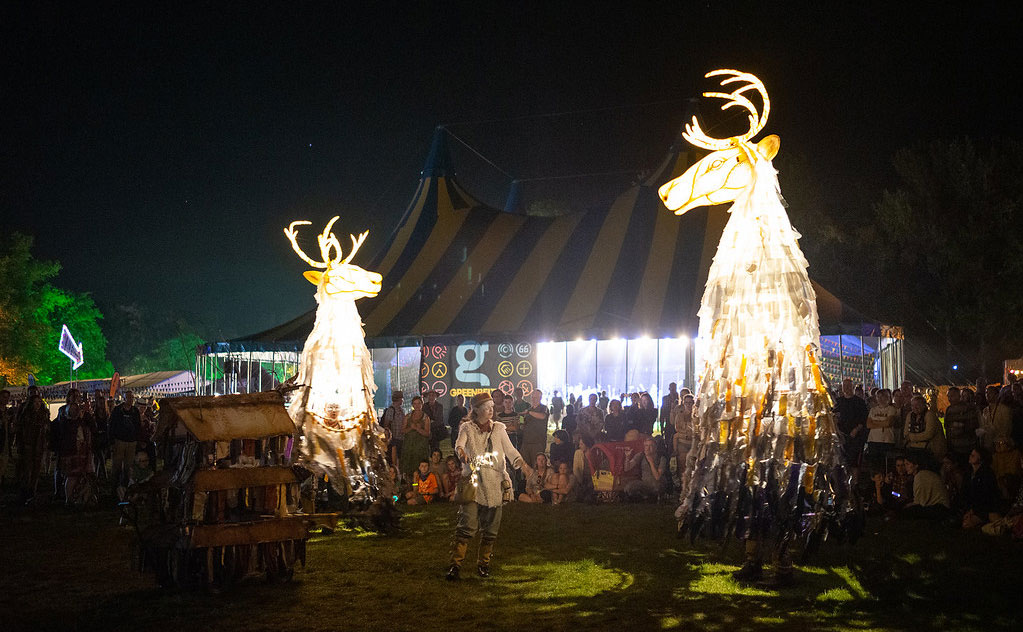Each year we conjure a theme here at Greenbelt to inspire and guide us in our creative decision-making. And in the hope that all of us, festival-goers and artists alike, will feel energised to have been a part of a bigger idea. This year our theme is Wild at Heart. Creative Director Paul Northup offers up some on his thinking …
Out of control
The gnarly Texan theologian Stanley Hauerwas characterises a good life of justice, creativity and faith as being one in which we learn to live ‘out of control’. He suggests that control is perhaps our modern disease. It’s the thing we seem most determined to have and to achieve in our lives. And yet it is, perhaps, the very thing that holds us back from living life in all its fullness.
So much of modern life – our politics, our economics, our education, our faith institutions – seems to be about assessing and mitigating risk, insuring against all eventualities. Now, risk assessment is vital (especially when you’re putting on an outdoor event for 10,000 or so people!), but my feeling is that even at an individual level, it’s perhaps becoming our pre-eminent mindset. It’s increasingly the lens through which we see all of life.
In 2017 at Greenbelt we had Charles Handy at the festival to speak about the ‘Second Curve’: his idea of jumping off onto another path in life, before the path that we’re on reaches its peak and flattens out; before things become dull, predictable, and controlled. Instead, Handy suggested that the art of living a full, good, productive and meaningful life was in seeing, and then being brave enough to jump onto, the second curve – the journey that will take us beyond what we can see and know in our controlled present.
Just as re-wilding will be vital to a sustainable future, so we also need to re-wild our beliefs, our politics, our economics, our schools and churches. We will need to free all these areas of human endeavour from the models that hold and control them.
Re-wilding our beliefs
When it comes to our belief, to the practices of our faith and the way we ‘follow’ as individuals, I would argue that we have largely tamed God. Which might well be understandable, but it is odd. Especially when, at the heart of all religious belief is the ‘Other’: the untameable, the almost-unknowable and unimaginable, God.
At the heart of our lives, at the heart of our faith, at the heart of our world and cosmos, there is mystery. The event horizon over which human knowledge and understanding disappear from view. Where God is far wilder than we would like to admit.
But we have domesticated that wildness – in song, liturgy, belief and action. We have sanitised and downplayed the wildness that lies at the centre of religious belief. Perhaps it’s the case that our faith, action and religious convictions are crying out for a re-wilding in order to be saved? Perhaps we need to re-wild the God we try to believe in and follow.
Re-wilding our imagination
Art happens at the boundary between what we can just about control and what lies beyond that. Art-making and creative expression is, perhaps, the primary human activity that combines the art of control (the skill and craft and discipline required to make art) with the elusive art of letting go and being open – to the Other, to inspiration, to the divine.
Whether we’re making it or experiencing it, art can take us beyond the confines of our worlds, experiences and capabilities, and into new imaginative territories with wider horizons and fresh perspectives. We are taken towards what is other. Our imaginations become paths of the spirit. We rediscover the power of the imagination.
Re-wilding our politics
A lot of us, myself included, probably think of ourselves as too reserved, too British to be real activists and campaigners. And yet in recent years, that ground seems to be shifting. It seems that we are learning how to recover our sense of outrage and protest. Pensioners have been arrested on London Bridges. School-children have gone on Friday strikes all over the world. The times demand it.
Activism requires us to set aside our control on life. Because the adventure of protest does not have a predictable outcome. At its heart, activism is about empathy – about setting aside our own controlled boundaries and entering into the feelings, circumstances and life of another. To see and feel things from another point of view. That requires imagination, it requires a faith of sorts. And it definitely requires a giving up of control. It demands we cross the street to take a walk on the wild side.
It’s a matter of the heart
And in all this, we felt it important in our Greenbelt theme for this year to root all these ideas and aspirations in the heart. It’s not just about embracing the wild. It’s about love. If we are to reverse the ravaging effects of the climate crisis fast enough we will need to fall in love again with the beautiful planet that’s our home. This will not be solved with will, technology or political policies alone. It will require love.
This is the heart of the matter and a matter for the heart. Unless we go wild, we will die. Control leads to death. Wildness is the way to life. As the late, great American poet and mystic Mary Oliver wrote in The Summer Day:
“Tell me, what is it you plan to do with your one wild and precious life?”
Pictured: Ghost Caribou, Greenbelt 2019

